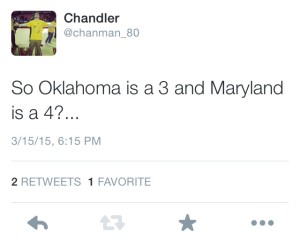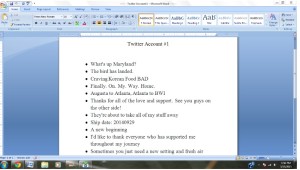In this class I was required to read part of the book “It’s complicated: The Social Lives of Networked Teens” by Danah Boyd. This book mentioned that people initially believed that the internet would lead to the end of racism and sexism as a whole citing the fact that people are anonymous online as the reason for its downfall. However this book then explored why researchers didn’t believe that this would be possible, mostly due to the fact that people in essence bring their social circles with them when they interact with others online. It was this book that inspired me to research the concept of racism, sexism, and anonymity in social networks. My research question was: how would people be able to interpret the race and gender of an individual based upon simply reading the raw text of their most recent social media updates without being given any other information.
In order to explore and attempt to answer this question I decided that I would pick Twitter as the social media site that I would use due to the fact that it is the most text based of the current, popular, social media sites as well as the fact that it is one of the more actively used sites among my peers. The method that I chose was to show these different pages of plain text to different people and asked them to determine the race and gender of the individual that the twitter account belonged to. In order to make sure there was an even distribution of race and gender I chose to include 3 twitter accounts each from an Asian male, an Asian female, a black male, a black female, a white male and a white female. These were all randomly chosen from the list of people that followed me on Twitter. I also chose to include the 15 most recent tweets that fit the criteria of being an all text tweet (no pictures included) and does not tag another user in order to avoid including conversations.

(Usable) (Not Usable)
I also opted not to include emojis in order to give each page of tweets the same appearance. Once I had picked the tweets that I would show to the guessers I chose to display them on a Word document with plain black text with each tweetappearing on a bulleted list where the only heading is “Twitter Account” and then a randomly selected number that compares to each twitter account.
I selected these numbers by writing each name on a piece of paper and randomly picked each piece to determine the order. When I went to interview the guessers I explained to them that they were looking at the 15 most recent tweets of an individual and they had to select a race from the possibilities of Asian, black, or white, and to guess gender as either male or female. I did not tell the guessers that there was an even number of each race and gender and I didn’t let them see what they had selected after they had made a decision. I then displayed the twitter accounts one at a time and didn’t switch to the next account until after the guesser had finalized an answer as to the race and gender of the individual. I recorded this data in the form of a table where I had the twitter account number down the first column and the race and gender of each guesser along the top row of the table. I then recorded the race and gender that they believed each twitter account to belong to.
I then summed up the amount of correct and incorrect guesses as well as the amount of times that each guesser chose each race and gender. In order to protect everybody’s privacy I only included information relevant to the experiment. I chose to only display each twitter account as a number, race, and, gender instead of their actual name or twitter handle. I also displayed each guesser in terms of their race and gender instead of their name. I also only used Twitter accounts that were already set to private.
My hypothesis was initially that people would have a difficult time differentiating the race and gender of an individual based solely on the text of their tweets but after I had set up the experiment and created the word document I had to change my hypothesis. I noticed that even within only the 15 most recent tweets an overwhelming majority of the 18 twitter accounts that I chose to examine had made explicit references to their own race and gender. My hypothesis directly before beginning the experiment was that the guessers would be fairly successful in determining the race and gender of the individual owners of the twitter accounts.
What I found was similar to my hypothesis but with some very notable differences. Among my responses there were 107 guesses that correctly identified race and gender out of 180 total guesses. That correlates to a 59% success rate. However, it is interesting to note that the success was not due to direct statements that identified race as I had assumed would be the case but rather due to “dialect” and “use of certain words” as one white male guesser noted. He noted that this also held true for gender, specifically he said he identified males if they discussed a topic such as sports or females if they discussed a topic such as dancing or makeup. Also nearly every single guesser identified that they went into the survey with a belief that they would be able to distinguish between white and black very easily but would struggle between Asian and white. This means that among the people that I surveyed there was a belief that there existed a very serious cultural divide between black and white yet very minimal differences between Asian and white. However there was no comment made about gender and when I asked one Asian male why, he responded with “I don’t know that just seemed like it would be easy”. Not only do preconceived cultural differences exist between races but they exist even between people of the same race with different genders! One white male noted something very important midway through his survey as he stated “when I can’t decide which answer it is my default is white male” and a black male said something similar as he stated that “when a tweet looks like something that I would think I assume it’s a black male”. This resulted in skewed results across the board as white males generally had more male guesses than female guesses and more white guesses than Asian or black guesses. This same pattern held true for the races and genders of the other guessers. There was no clear distinction between the race or gender of an individual and the percentage of correct guesses. In terms of answering my initial research question I believe that people are able to successfully distinguish the race and gender of an individual based solely on the raw text of their social media updates. Relating this topic back to the initial Boyd reading that discussed anonymity my results provide evidence for the fact that individuals do, in fact, bring their social network with them when they go online resulting in a difference not only in who people communicate with but also in how they communicate with each other.


